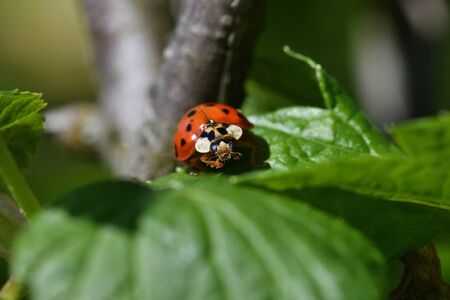Introduction: Appreciating the UK’s Garden Wildlife
In every corner of a British garden, from the tangled hedgerow to the neat vegetable patch, life buzzes and bustles in fascinating ways. Growing up in the countryside, I remember my grandmother pausing her weeding just to point out a ladybird nestled among the roses or to watch a blackbird hopping after worms on a rainy morning. She would say, “Everything has its place—even the bugs that nibble your lettuce.” This traditional viewpoint carries a wisdom often overlooked: while we may grumble about slugs or aphids, these so-called pests and their natural predators are all part of the delicate balance that makes our gardens thrive. In fact, many of us find ourselves caught between wanting pristine crops and appreciating the wildlife that brings our outdoor spaces to life. As we explore how to manage both beneficial insects and garden pests, it’s worth remembering that a truly healthy British garden is rarely free from either; rather, it flourishes when nature is allowed its gentle tug-of-war.
Identifying Key Beneficial Insects
If you’ve spent any time pottering about in your garden, you’ll know that not all insects are foes. Some are the quiet heroes, working behind the scenes to keep pests in check and help your plants thrive. In a typical UK garden, it’s important to recognise these helpers so you can give them a warm welcome rather than an accidental eviction. Let’s take a closer look at three of the most valuable allies: ladybirds, lacewings, and bees.
Ladybirds (Ladybugs)
Ladybirds are perhaps the most well-loved of all garden insects here in Britain. Easily identified by their bright red or yellow shells spotted with black, these little beetles are voracious consumers of aphids—a common pest that can sap the strength from roses and beans alike. If you spot clusters of orange eggs or small black larvae on your plants, don’t be too quick to wipe them away; they’re often the next generation of ladybird hard at work.
Lacewings
Lacewings may not be as instantly recognisable as ladybirds, but they are just as valuable. Adults have delicate green wings that shimmer in the sunlight, while their larvae—sometimes called “aphid lions”—are ferocious predators of aphids and other soft-bodied pests. Look for them in sheltered areas such as hedges or amongst tall grasses, especially during the milder months when they’re most active.
Bees
No conversation about beneficial insects would be complete without mentioning bees. From fat bumblebees bumbling through foxgloves to solitary bees nesting in crumbling walls or drilled logs, these pollinators are vital for everything from apples to runner beans. In the UK’s sometimes unpredictable climate, bees favour gardens with a succession of blooms and safe places to shelter from wind and rain.
Spotting Beneficial Insects in UK Gardens
| Insect | Where to Find Them | When They’re Active |
|---|---|---|
| Ladybirds | On leaves infested with aphids; under loose bark | Spring through autumn |
| Lacewings | Sheltered corners, hedgerows, tall grass | Mainly spring and summer evenings |
| Bees | Flowering plants; holes in wood or soil for nests | Early spring until late autumn, depending on species |
Tips for Encouraging These Helpers
Avoid using broad-spectrum pesticides, as these can harm beneficial insects along with pests. Provide a variety of flowering plants throughout the year to support pollinators like bees. Leave some undisturbed corners or natural debris where lacewings and ladybirds can overwinter safely. With a keen eye and a gentle hand, you’ll soon find your garden humming with helpful activity.

3. Recognising Common Garden Pests
If you’ve ever spent time pottering about in a British garden, you’ll know that not every visitor is a welcome one. While many insects play vital roles, there are a few notorious troublemakers that regularly make their presence known. Knowing how to spot these common pests—and the calling cards they leave behind—can help keep your borders blooming and your veg patch productive.
Aphids: The Silent Sappers
Aphids, often referred to as greenfly or blackfly, are tiny sap-sucking insects that gather in clusters on new shoots and the undersides of leaves. You might notice leaves starting to curl or yellow, or see a sticky residue known as ‘honeydew’—a sure sign aphids have set up shop. Left unchecked, these little blighters can weaken plants and even spread viruses, so it’s well worth keeping an eye out for them.
Slugs: Night-Time Nibblers
No list of British garden pests would be complete without mentioning slugs. These slimy molluscs emerge after dark or following rain, leaving ragged holes in lettuce leaves, hostas, and seedlings. A tell-tale trail of silvery slime across patios and soil is their calling card. Slugs can decimate young plants overnight, making them a persistent foe for gardeners up and down the country.
Vine Weevils: The Root Wreckers
Vine weevils are another pest that’s earned its reputation through sheer destructiveness. Adult weevils chew notches in leaf edges during spring and summer evenings, but it’s their grubs—lurking unseen in the soil—that do the real damage by munching on plant roots. Wilting foliage and sudden plant collapse are signs to watch for, especially if you’re growing container plants or favourites like primulas and heucheras.
Reading the Signs
Whether it’s curled leaves from aphids, slime trails from slugs, or notched foliage thanks to vine weevils, recognising these indicators early gives you a fighting chance. As any seasoned British gardener will tell you, vigilance is half the battle when it comes to keeping your plot thriving without resorting to drastic measures.
4. Natural Methods for Encouraging Beneficial Insects
Drawing from decades of pottering about in British gardens, I can tell you there’s nothing quite like watching your patch come alive with ladybirds, lacewings, and hoverflies—all doing their bit to keep pests in check. If you’re keen to tip the balance in favour of these garden allies, there are some time-honoured ways to go about it, firmly rooted in our local traditions and a respect for nature’s own rhythms.
Planting Native Species
First things first: native plants are the backbone of any wildlife-friendly British garden. Plants that have evolved alongside our insects provide them with the right food and shelter. Here’s a quick look at some favourites:
| Native Plant | Insect Attracted | Seasonal Interest |
|---|---|---|
| Hawthorn (Crataegus monogyna) | Lacewings, bees, butterflies | Spring blossom, autumn berries |
| Foxglove (Digitalis purpurea) | Bumblebees | Early summer flowers |
| Cow Parsley (Anthriscus sylvestris) | Hoverflies, parasitic wasps | Late spring umbel blooms |
| Ivy (Hedera helix) | Bees, hoverflies, late pollinators | Autumn nectar source |
Creating Habitats and Shelter
A well-tended but slightly wild corner does wonders for attracting helpful insects. Old logs, piles of twigs, and stone walls offer vital nesting and overwintering spots. Don’t be too quick to tidy up every leaf or dead stalk—these are five-star hotels for bugs! Consider a bug hotel or even just leave a patch of nettles; both will bring in a host of beneficial creatures.
Traditional Gardening Practices That Make a Difference
- Crop Rotation: Rotate your vegetable beds each year. This old-fashioned method keeps soil healthy and confuses pest populations, giving your beneficial insects an upper hand.
- No Dig Approach: Disturbing the soil as little as possible protects ground beetles and other helpful critters that live just below the surface.
- Mixed Planting: Companion planting—mixing herbs like chives or marigolds among your veg—helps attract good insects while deterring the not-so-welcome ones.
- Pond or Water Feature: Even a small pond draws in dragonflies and frogs, both excellent at keeping down mosquito numbers.
A Little Patience Goes a Long Way
If there’s one thing years in the garden teach you, it’s patience. Letting nature find its balance takes time. Avoid chemical sprays where possible; they often harm friends more than foes. With thoughtful planting and a touch of traditional wisdom, your UK garden will soon be bustling with life—and your roses and runner beans will thank you for it.
5. Balancing Pest Control with Sustainability
When it comes to keeping your UK garden healthy, the trick is to deal with pests without upsetting the delicate balance that allows beneficial insects to thrive. Over the years, I’ve found that old-fashioned, organic methods often work best—there’s a reason our grandparents swore by them! Let’s look at some tried-and-true tips for managing pests while giving nature a helping hand.
Choose Organic Solutions First
Before reaching for anything synthetic, consider remedies that have stood the test of time. Soap sprays made from mild washing-up liquid and water can help control aphids without harming ladybirds or lacewings. Scatter crushed eggshells or sharp sand around young plants to deter slugs and snails—no chemicals needed.
Encourage Natural Predators
One of the most effective ways to manage pests is to make your garden welcoming for their natural enemies. Planting hedgerows, wildflower strips, or even a simple bug hotel provides shelter for ladybirds, hoverflies, and ground beetles. These helpful creatures will do much of the pest control for you if you give them a home.
Practice Companion Planting
The age-old technique of companion planting is as relevant today as ever. For example, marigolds not only add colour but can also repel whitefly and attract pollinators. Nasturtiums draw aphids away from your prize veg, acting as a living trap crop.
Hand-Picking and Vigilance
Nothing beats a daily stroll around the garden with a keen eye. Hand-picking caterpillars or squashing greenfly may sound old-fashioned, but it’s remarkably effective and ensures you’re not disturbing the wider ecosystem.
Avoid Harmful Chemicals
Steer clear of broad-spectrum pesticides—they kill both friend and foe alike, often doing more harm than good in the long run. Instead, use barriers like netting or cloches to protect vulnerable crops, especially during peak pest seasons.
Create a Balanced Environment
Above all, remember that a diverse garden is a resilient one. The more variety you plant, the less likely any single pest can take hold. In my experience, patience and observation are your best tools: let nature find its balance and step in gently when needed.
6. Real-Life Experiences from the Allotment
There’s nothing quite like a brisk morning stroll down to the allotment, thermos in hand, and the anticipation of what surprises await amongst the beds. Over the years, I’ve seen firsthand how striking a balance between helpful insects and unwelcome pests is a subtle art – one that many British gardeners learn through trial, error, and a fair bit of tea-fuelled chat with neighbours.
Take my old friend Mrs. Cartwright, who has tended her plot for over thirty years. She used to wage war on greenfly with every spray she could find at the garden centre. But after a few seasons, she noticed there were fewer ladybirds about – those charming, spotted helpers who love nothing more than a feast of aphids. Now, she plants marigolds and nasturtiums as sacrificial crops, luring the pests away from her prized runner beans while giving ladybirds a reason to stick around. As she often says, “It’s about working with nature rather than against it.”
I recall one particularly memorable summer when we all faced an invasion of cabbage white butterflies. Many new allotmenteers reached for netting and soap sprays, but old hands like Mr. Patel shared tales of companion planting and encouraging birds into the garden by setting up feeders and birdbaths. Slowly, the robins and blue tits took care of many of the caterpillars for us – not perfectly, but enough that we still had cabbages to show at the village show come September.
What stands out from these experiences is a sense of community wisdom and resilience; here in Britain, gardening is rarely just about produce. It’s about adapting year after year, sharing tips over shed doors or at seed swaps, and learning which combinations work best for your patch of earth. The underlying lesson is clear: patience pays off, and letting beneficial insects find their place can make for healthier gardens in the long run.
If you ever feel frustrated by slugs or overwhelmed by blackfly, remember that every seasoned gardener you meet has been there too – swapping stories about hedgehogs munching snails or the first time they spotted a lacewing larva hard at work. It’s these small victories and setbacks that make gardening in the UK such a rewarding pursuit, teaching us not only how to grow food but also how to foster a more balanced ecosystem right outside our back doors.
7. Conclusion: Living in Harmony with Nature
As we draw this conversation to a close, it’s worth remembering that gardening in the UK has always been about more than just plants—it’s about the ebb and flow of life itself. Our grandparents and their parents before them knew the value of patience, observation, and respect for the natural world. By nurturing beneficial insects and managing pests without harsh chemicals, we’re simply continuing a time-honoured tradition. The garden is a living tapestry, woven with both helpers and challengers, each playing a part in the cycles that shape our outdoor spaces. Rather than seeking total control, let us strive for balance—welcoming ladybirds as well as finding gentle ways to deter aphids. Celebrate those moments when nature finds its own equilibrium, because these are signs of a healthy, thriving plot. So go on, take a cuppa out to your patch, watch the bees at work and the robins hopping about. Trust that with care and understanding, you can foster a garden that’s rich in life and beauty—a legacy to pass down as generations have done before.


